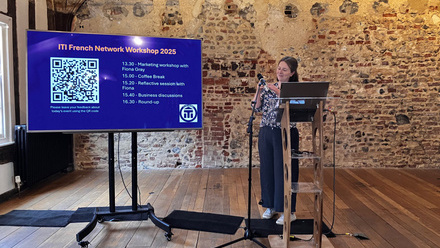Portfolio living
A professional engagement portfolio is a thoroughly useful tool for anyone studying translation, Hayley Smith explains - even if you never actually show it.
My fellow early-end millennials and adjoining ‘xennials’ (those born roughly between 1975 and 1985, apparently) who attended state school in the UK might remember a burgundy faux-leather-bound portfolio called the National Record of Achievement. I took putting this together very seriously, and my certificates for ‘most read library books 1998-99’, ‘100 French words learned’, my Head Girl award and so on were inserted into the plastic pockets with pride.
But then, when I transitioned merrily into the working world, guess what? Nobody even wanted to take a glimpse at my meticulously curated portfolio – not even Stockport McDonald’s, which might have actually given me that Saturday job if they had.
I admit it: I was wrong. I have never actually shown any prospective clients my PEP - but I massively underestimated just how useful it would be.
Language outside the class
The idea behind the PEP is that, as a student, you make a record of all the things you’ve done relating to translation, interpreting or your language skills outside your actual studies. Sound familiar?
Yes, it’s effectively continuing professional development (CPD) for people who are still building up to being professionals. If we consider studies as a ‘day job’, there are of course so many things you could be doing to ensure you are as prepared as possible to flourish in your chosen future career. So why not begin CPD as soon as possible? Just like CPD, eligible activities for the PEP are varied. Joanna was very keen that we set one up, and we were encouraged to submit it to tutors at the end of the course, but the layout and exactly what to include were very much left to us.
If you were a particularly visual person, for example, it could take the form photographs. Being an excessively wordy type, I opted for prose.
I kept notes throughout the year and, when I came to type up my PEP for submission, six clear themes identified themselves – memberships (such as ITI and associated networks), workshops and conferences (the ITI Conference being the real highlight), short courses (such as in proofreading and machine translation post-editing – MTPE), networking opportunities, voluntary work and our translation studies seminars.
The programme of seminars thoughtfully put on at Surrey is vital for career considerations outside your course content – Kari Koonin gave us an excellent overview on accounting for translators, and I met our very own Paul Appleyard (a Surrey alumnus himself) at the Engaging with Professional Organisations session.
Helping to break the barriers
Where the PEP really comes into its own is when you’re finally embarking on putting together your first CV for employers. Joanna reminded me that the information in my PEP was the perfect way to demonstrate that I had already had significant experience in the broader industry, without even realising it. And this is even more important for people who haven’t had a previous career, to teach them the importance of networking and/or hunting out new potential opportunities.
Despite my initial views I can’t deny that, unlike the dreaded Record of Achievement, the PEP turned out to be a hugely useful exercise. It wasn’t why I chose to attend certain events, or to undertake the pro bono work I did. But it was always there in the back of my mind, and all the work I have secured to date can be attributed to people I met through those activities.
Unlike the Record of Achievement, a physical copy of my PEP is a nice thing to have, but it was undoubtedly the journey to complete it, rather than the finished product, that paid dividends when my course finished.
This article first appeared in the September/October 2020 edition of the ITI Bulletin.
About the writer

Hayley Smith is an ITI Affiliate Member and member of the ITI Board, as well as the proud founder of Hayley Smith Language Services. A passionate Francophile, she hopes to enter the world of theatre translation one day, but for now, is specialising in the translation of medical texts and charity communications.






